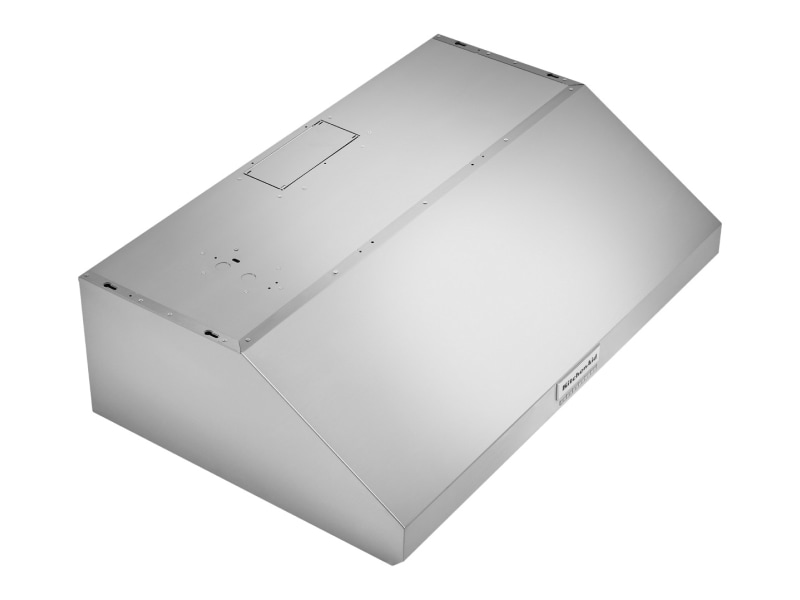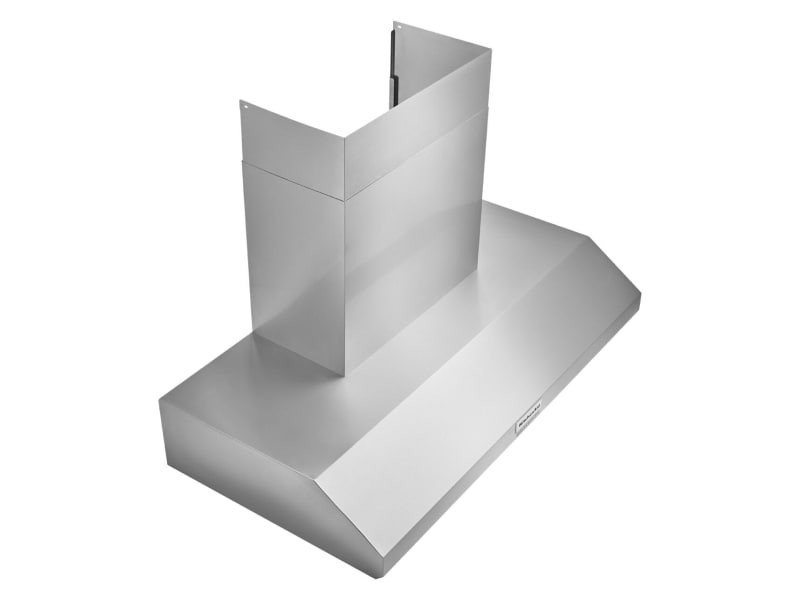
How does a range hood work?
Range hoods help keep the air clear so you can stay focused on flash frying, sauteing or searing your favorite dishes. Read the guide below to learn more about the parts of a range hood, how different types of hoods work, whether range hoods need venting and tips for installation.


What is a range hood?
Range hoods are kitchen appliances designed to help clear the air above the cooktop surface during cooking. They’re most often mounted to the wall above the cooktop or the ceiling above a kitchen island and vent air through ductwork to the outside or filter and recirculate air back into the kitchen.


What does a range hood do?
As grease, smoke and moisture rise from a cooktop’s surface, range hoods use an active fan to draw particles into the hood and, depending on the model, move it through ductwork to the outside of the home or filter the air and recirculate it back into the kitchen.
Range hoods and microwave hood combinations can help clear the air of odors and help prevent the cooking space from becoming stifled with heat. Most range hoods also feature lighting that adds visibility to the cooktop below.
What are the parts of a range hood?
Getting to know the parts of your range hood can make it easier to keep up with maintenance or know where to look if something goes wrong. Read below to learn about 6 main components of a range hood.

1. Blower
The blower is the core of a range hood and consists of a motor-powered fan encased in a protective housing. This essential component is responsible for drawing in the airborne grease, smoke and odors that rise from the cooktop, then moving air up and out of the home or—for ductless range hoods—through various filters before pumping it back into the kitchen. All range hoods have a designated CFM (cubic feet per minute) rating, with higher CFMs indicating more powerful venting capabilities.

2. Lighting
Many range hoods come equipped with built-in lamps that illuminate the cooking surface below, helping you keep an eye on the details of any braised, poached or sauteed dish. Some models—like the KitchenAid® 36" Wall-Mount, 3-Speed Canopy Hood—also feature ambient lighting with a halogen light that provides a soft, inviting glow at night.

3. Grease filter
A range hood’s grease filter is a large, metal rectangle positioned on the underside of the hood. The filters help trap grease and other food particles, so they should be cleaned regularly. Larger models may feature multiple filters to help clear air from a heavily used cooktop.

4. Hood canopy
The hood canopy assembly acts as the body of the range hood and typically houses the lamps, grease filter and control panel. They’re usually wide and rectangular, mirroring the dimensions of the cooking surface below.

5. Duct cover
Duct covers extend above the range hood canopy and encapsulate the vent system and—for vented models—help direct particulates out of the home. The duct cover houses the ductwork for systems that vent through the wall or ceiling.

6. Control panel
The control panel is typically positioned on the front of the range hood canopy for quick access. Standard range hood control panels include on/off options for both the blower and lights, but advanced models can include a variety of options for a more customized experience. The KitchenAid® 42'' Island-Mount, 3-Speed Canopy Hood, for instance, features glass touch controls for low, medium, high and auto speed settings, as well as a Power Boost function.
How do different types of range hoods work?
Range hoods come in a variety of configurations, including wall mount canopy, under-cabinet, island, microwave hood combination or downdraft models. Installation and aesthetics vary from model to model, but all range hoods vent air through external or recirculating ventilation systems. Read below to learn how ductless, ducted, downdraft and convertible range hoods operate.

1. How do ductless range hoods work?
Ductless range hoods use recirculating ventilation to clear air above the stovetop. Smoke, moisture and grease pulled into the hood move through grease and charcoal filters inside the vent system to help clear the air of contaminants, then recirculate back into the kitchen. These range hoods don’t require ducting, so they can be installed almost anywhere. Most KitchenAid® wall mount, island mount and microwave hood combination models, for instance, can be configured as both ducted and ductless range hoods so you can install them wherever suits your kitchen best.

2. How do ducted range hoods work?
Ducted—or vented—range hoods use external ventilation and are connected to a duct in the wall, ceiling or floor that extends to the outside of the house. These range hoods pull smoke, odors and grease from the air and funnel it through ductwork to the outside of the home. Commercial-style range hoods like these ones from KitchenAid brand are typically ducted.

3. How do downdraft range hoods work?
These sleek and subtle vent hoods are installed in the cabinetry behind the cooktop and work to pull steam, smoke and grease across the cooktop surface and down into the hood vent. Downdraft range hoods—like these models from KitchenAid brand—typically rise several inches above the cooktop while in use, then completely retract into the cabinetry below once the work is done. While these hoods can vent outside through the floor or wall, they can also be configured to recirculate for ductless ventilation.
Range models like this KitchenAid® 30-Inch 4-Element Electric Downdraft Slide-In Range feature an integrated downdraft hood built into the cooktop so there’s no need for a separate range hood appliance.

4. How do convertible range hoods work?
Convertible range hoods—like select KitchenAid® wall mount and island mount range hoods—allow you to configure your model to function as a ducted or ductless hood. Once installed, convertible range hoods work just as their ducted or ductless counterparts would to clear air by either external or recirculating ventilation.
How does a range hood filter work?
Recirculating range hoods help clear grease, odors and smoke from the air by moving it through a filter and back into the kitchen rather than pushing air through ductwork to the outside of the house. These hoods can include a charcoal filter to help combat odors and a grease filter to trap grease and other food particles as air enters the range hood.


Do range hoods need to be vented?
Some types of range hoods—called vented or ducted range hoods—transport odors outside of your home through installed ductwork. Ventless, or ductless, range hoods filter then recirculate air back into the kitchen without venting outside.
Canopy and downdraft range hoods typically vent outside while under-cabinet models like microwave hood combinations are usually prepared to filter and recirculate air. Some hoods can convert from vented to ventless, or vice versa, with the help of a conversion kit.
Do range hoods need to be vented outside?
Not all range hoods need ventilation, but vented or ducted models do always vent to the outside of a home. This venting can run through an exterior wall, floor or—with the help of a professional—be installed up and out through the roof.
How do range hood vents work?
Ducted range hoods vent the air using a fan to help draw smoke, grease and moisture out of the air and into the ventilation duct installed above or behind the range hood. The air travels through the duct and out through the exterior vent pipe located outside the home.
Some range hoods include a damper in the ductwork, which opens to allow airflow when the range hood is operating and closes when it’s not to help prevent debris and backdrafting during the ventilation process.


Can I install a range hood myself?
You can install a range hood without the help of a professional if you have the right tools and installation instructions for your specific model. A second pair of hands can be helpful when it comes time to mount the range hood, and it’s best to recruit professional help if your new range hood requires you to move plumbing, rewire or drill through the roof.
You can contact KitchenAid service and support for help installing or troubleshooting any KitchenAid brand appliance.
Shop KitchenAid®range hoods
Range hoods from KitchenAid brand feature the form and function you need to help keep the kitchen air clear and create a bold aesthetic. Select models include intuitive functions like the Auto Speed setting that automatically adjusts the fan’s speed to match the heat being produced. With KitchenAid® wall mount, island mount, commercial-style and microwave hood combination models, you’re sure to find the right addition to your workspace.
Was this article helpful? Pass it on
Learn more about range hoods with KitchenAid brand
-
 6 Types of Range Hoods for Any Kitchen What’s the best range hood for your kitchen? Explore different types of kitchen hoods and learn what to consider before choosing a range hood for your home.
6 Types of Range Hoods for Any Kitchen What’s the best range hood for your kitchen? Explore different types of kitchen hoods and learn what to consider before choosing a range hood for your home. -
 Range Hood vs. Microwave: Vent Hood Options Should you install a range hood or an over-the-range microwave in your kitchen? Compare range hoods to microwave hoods to find the best fit for your kitchen.
Range Hood vs. Microwave: Vent Hood Options Should you install a range hood or an over-the-range microwave in your kitchen? Compare range hoods to microwave hoods to find the best fit for your kitchen. -
 Range Hood Sizes: How to Choose the Right One Not sure what range hood vent size you need? Find out which range hood dimensions are the right fit for your range and kitchen with our guide.
Range Hood Sizes: How to Choose the Right One Not sure what range hood vent size you need? Find out which range hood dimensions are the right fit for your range and kitchen with our guide.